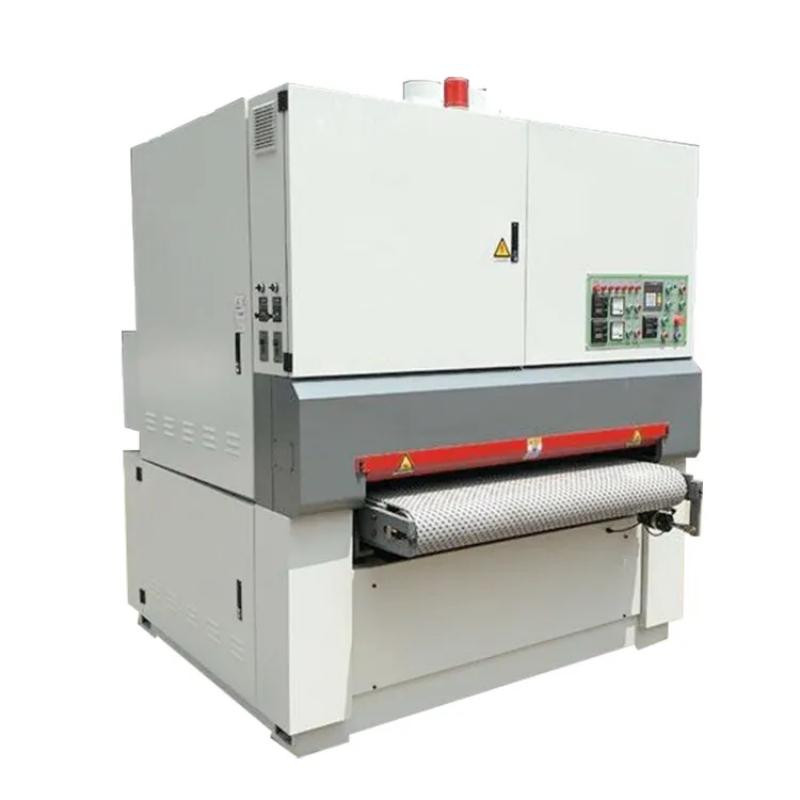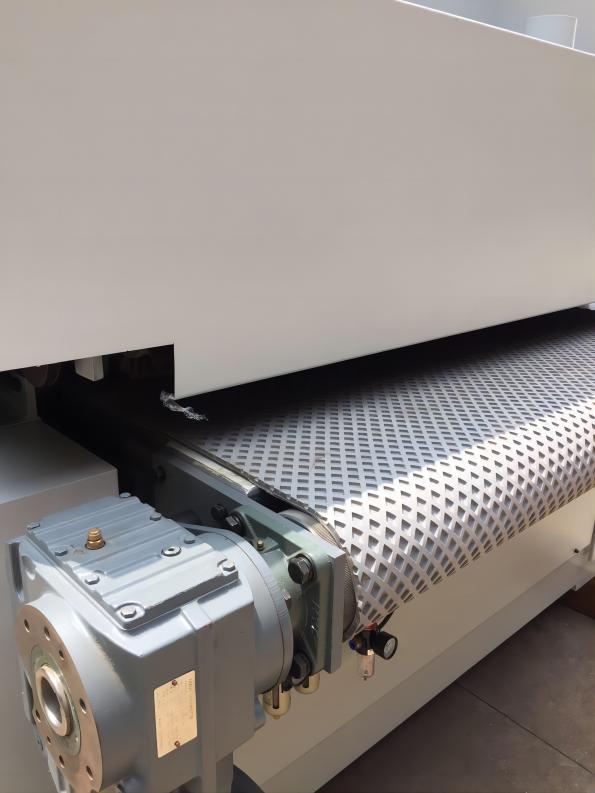In modern industrial production, surface treatment is a critical step in ensuring product quality and precision. As an efficient and reliable surface treatment device, the industrial roller sander, with its unique structure and operating method, plays a vital role in numerous industries.
Not only can industrial roller sanders smooth and sand large areas, but they also improve the surface finish and uniformity while maintaining processing efficiency. They are indispensable equipment for processing wood, metal, and composite materials.

Industrial Roller Sanding Machine: Everything You Need to Know
An industrial roller sander is a mechanical device that uses a rotating drum to drive sandpaper or cloth to sand, polish, and smooth the surface of a workpiece. The core principle is that the rotation of the drum creates friction between the abrasive and the workpiece surface, removing burrs, protrusions, and unevenness, achieving the desired flatness and finish.
The main components of an industrial roller sander include:
a drive system, a sanding drum, a feed mechanism, a pressure regulator, and a dust removal system. The roller is a key component. Its continuous rotation evenly compresses the workpiece surface, achieving highly efficient and precise sanding. The feed mechanism ensures that the workpiece passes continuously and evenly across the roller surface, making the sanding process automated and highly consistent.
Working Principle of the Industrial Roller Sanding Machine:
The working principle of the industrial roller sanding machine embodies the efficiency of mechanized sanding. By precisely adjusting the roller speed, sandpaper type, and sanding pressure, it can perform both rough machining to remove large surface defects and fine polishing to improve workpiece smoothness and surface uniformity.

Industrial Roller Sanding Machine: Structural Features
The industrial roller sanding machine has unique structural advantages that make it excellent for sanding large surfaces:
1. Roller Design
The sanding drum of an industrial roller sander is typically made of high-strength steel or aluminum alloy and covered with abrasive cloth or sandpaper to ensure wear resistance and stability. The drum diameter and length can be customized to accommodate workpieces of varying sizes.
2. Automatic Feed Mechanism
Industrial roller sanding machines are typically equipped with an automatic feed system to ensure that workpieces continuously pass over the roller surface, achieving uniform sanding. The feed speed is adjustable to accommodate different materials and sanding requirements.
3. Pressure Control
During the roller sanding process, pressure control is crucial. Industrial roller sanding machines are equipped with precise pressure control to adjust the roller force based on the workpiece material and surface condition, ensuring uniform sanding without damaging the material.
4. Dust Removal System
Industrial roller sanding machines generate a large amount of dust during operation. Modern equipment is typically equipped with efficient dust extraction or collection systems to maintain a clean processing environment and prevent dust from contaminating the workpiece surface or damaging the machine's internal structure.

What are the uses of industrial roller sanding machines?
Industrial roller sanding machines have a wide range of applications, primarily in woodworking, metalworking, composite surface treatment, and building material production. Their uses extend beyond surface smoothing to include enhancing finish, controlling thickness, and pre-processing.
1. Applications in Wood Processing
In the wood processing industry, industrial roller sanding machines are essential equipment for smoothing and polishing wood surfaces. Specific uses include:
• Removing burrs and imperfections from wood surfaces: Industrial roller sanding machines effectively remove burrs, cracks, and uneven surfaces from sawn and planed wood, resulting in a smooth, even surface.
• Controlling board thickness uniformity: In the processing of plywood, multilayer boards, or solid wood boards, industrial roller sanding machines precisely control roller pressure to achieve uniform board thickness, providing a precise foundation for subsequent processing.
• Improving wood surface finish: Industrial roller sanding machines can perform fine sanding, resulting in mirror-like smoothness that meets the surface requirements of painting, coating, or veneering processes, enhancing the product's aesthetics and performance.
• Furniture Production Applications: In furniture manufacturing, industrial roller sanding machines can perform batch sanding on large surfaces such as door panels, tabletops, and cabinets, ensuring a flat and smooth surface and providing an ideal foundation for subsequent painting.
2. Applications in Metalworking
Industrial roller sanding machines are primarily used in metal surface treatment and precision machining:
• Deburring and Smoothing: Metal parts produce burrs and weld protrusions after stamping, cutting, or welding. Industrial roller sanding machines can remove these irregularities through continuous roller sanding, smoothing the metal surface.
• Surface Finish Improvement: Industrial roller sanding machines can be used for polishing metals such as steel, stainless steel, and aluminum alloys, improving surface finish to meet assembly, coating, or appearance requirements.
• Thickness and Dimension Control: In precision sheet metal processing, industrial roller sanding machines can achieve uniform thickness control and ensure machining accuracy by adjusting roller pressure.
• Surface Pretreatment of Metal Parts: Industrial roller sanding machines can also be used for surface pretreatment prior to painting or electroplating, removing surface oxide layers, welding slag, and impurities, improving coating adhesion and surface quality.
3. Applications in Composite and Plastic Processing
In the composite and plastic processing industries, industrial roller sanding machines are used for surface leveling and fine grinding:
• Surface Treatment of Composite Sheets: For materials such as fiberglass reinforced plastics, carbon fiber sheets, and plastic sheets, industrial roller sanding machines can remove burrs and uneven layers, smoothing the surface and preparing it for subsequent processing.
• Finish Control: Industrial roller sanding machines can achieve fine grinding of composite surfaces, ensuring a uniform surface finish that meets industrial process requirements.
• Processing Thickness Adjustment: In composite production, industrial roller sanding machines can be used to control sheet thickness uniformity, ensuring that products meet design standards and improving processing accuracy.
4. Applications in Building Materials and Stone Processing
Industrial roller sanding machines are also widely used in the building materials industry:
• Smoothing Stone Surfaces: Industrial roller sanding of building materials such as stone slabs and ceramic panels can remove rough or uneven surfaces, resulting in a smooth and even surface.
• Improving Surface Finish: Industrial roller sanding machines can enhance the surface finish of stone, ceramic slabs, and other materials through fine sanding, ensuring the aesthetics and decorative effect of the building materials.
• Thickness Control and Processing Consistency: When processing large quantities of building materials, industrial roller sanding machines can ensure uniform thickness and precise installation.

What are the advantages of using industrial roller sanding machines?
The wide range of uses of industrial roller sanding machines is closely related to their high efficiency, stability, and controllability:
• High Processing Efficiency: Industrial roller sanding machines can operate continuously for extended periods, enabling large-scale batch processing and significantly improving production efficiency.
• Stable Surface Quality: Drum sanders mechanically control sanding pressure, rotation speed, and feed rate to ensure consistent sanding results on every workpiece.
• High Adaptability: Industrial roller sanding machines can adapt to workpieces of varying materials, thicknesses, and surface requirements by replacing sandpaper or abrasive cloth, and adjusting the roller pressure and speed.
• Low Labor Intensity: Automated feeding and sanding processes reduce operator workload and improve safety.
• Reliable Precision Control: Industrial roller sanders precisely adjust roller force to achieve uniform workpiece thickness and fine surface control, meeting high-standard processing requirements.
Industrial Roller Sanding Machine: How to Properly Operate and Maintain It?
To fully utilize the purpose and performance of an industrial roller sander, proper operation and maintenance are essential:
• Proper Installation and Commissioning: The industrial roller sander must be placed on a flat, solid surface to ensure stable operation, and must be carefully commissioned before use.
• Regularly inspect the abrasive and roller: Check the wear of the sandpaper or abrasive cloth and replace it promptly to ensure the sanding effect; regularly inspect the roller surface and the condition of the drive mechanism.
• Clean dust and maintain the dust removal system: Dust generated by the industrial roller sanding machine should be cleaned promptly, and the dust removal system should be kept unobstructed to prevent it from affecting equipment performance and workpiece surface quality.
• Safe operating procedures: Operators should wear protective equipment and follow operating procedures to prevent damage to the workpiece or equipment.
What makes XMF Machinery’s equipment environmentally friendly?
XMF Machinery is committed to producing high-quality machines that are also environmentally friendly. Our coating equipment is designed for energy efficiency, reduced waste, and clean production processes.
As a manufacturer and supplier, we focus on customized solutions that meet global environmental standards. This makes XMF Machinery the brand of choice for companies seeking efficient and green coating solutions.
